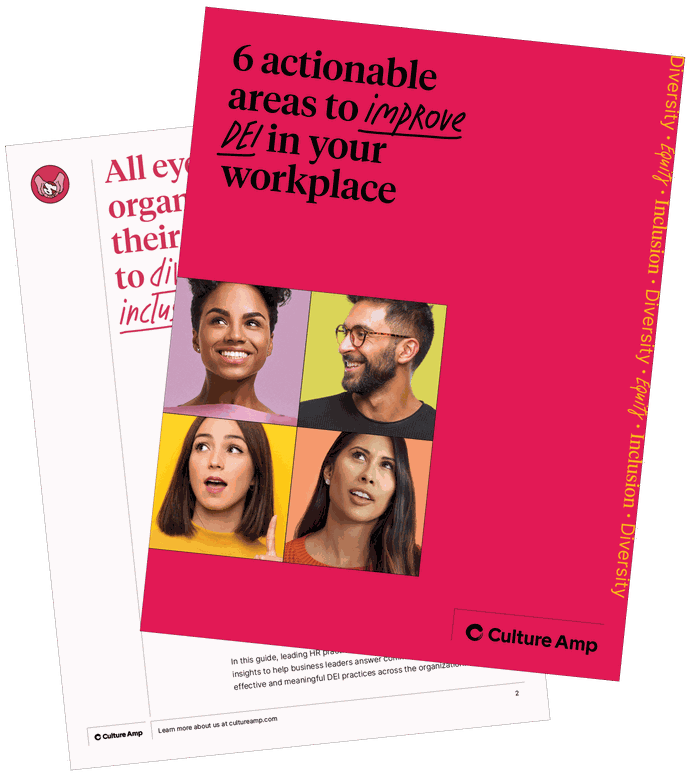3 reasons why traditional diversity metrics don’t work

Imagine you've committed to becoming a healthier version of yourself. And, imagine you want to use data to help you.
You might start with weight and calories because those are easy measurements. But if you took the time to do some research, you'd discover that your health is dependent on so many other factors; for example, the mix of fat, protein, and carbs you eat. There are other levers you'll need to pull to achieve your goal, like committing to physical activity, drinking plenty of water, getting enough sleep, and reducing stress.
You might also start to realize that your weight is only one part of the picture - that being healthy also means getting sick less, being able to relax and connect with loved ones, and feeling good about yourself and the contributions you're making to the world.
Human health is so much more than simply weight and calories, just like a diverse and inclusive culture is so much more than simply gender and race.
Despite years of effort, the tech industry is still not seen as a welcoming place for underrepresented groups. I strongly believe it’s because we’ve been measuring workplace diversity by only weighing ourselves and counting calories. Specifically, there are three reasons why traditional diversity metrics have not worked.
Reason #1 - Diversity metrics only focus on representation
The metrics that Facebook, Google, LinkedIn, Twitter, and other tech companies release each year are focused on representation (e.g. how many people in this group do you have). This is the equivalent of only measuring our weight and calorie intake. It doesn’t tell us how to make tech companies more diverse and inclusive. Hiring quotas are like calorie counts - they’re fixated on measurement, not solutions. Just because something is an easy measure, doesn't mean it's the right measure.
This is why we developed the Inclusion Survey in partnership with Paradigm. Our survey goes further than representation. It measures the employee experience. In an inclusive company, no aspect of an employee’s unique social identity impacts their ability to be successful.
Designed as an open-source project, the Inclusion Survey captures engagement metrics, seven research-based constructs of inclusion, and individual demographic data. It’s the first tool to accurately measure inclusion as well as diversity. It allows organizations to understand if underrepresented groups have a different employee experience from a majority group, which is a better indicator of health than relying on representation.
Now that we’ve run the survey with tech companies in Silicon Valley and beyond, we’ve aggregated and studied the results, which are presented in our Diversity, Inclusion, and Intersectionality Report. Belonging is the most robust and consistent driver of engagement; diversity is not.

Improve DEI in your workplace
Download the ebookReason #2 - Diversity metrics ignore our unique combination of traits
We are more than just men, women, white, or black. The Head of People at Culture Amp is a white woman - and a mother. I am an Asian male - and gay. By reducing our unique combination of traits into the easiest ones to measure, we are holding ourselves to only a few visible metrics. Our diversity is in the breadth of our experiences, backgrounds, and visions of the future. Our diversity is intersectional. Don't lump me into the “Asian male” group - I'm much more complex than that.
Using only race and gender is not indicative of an inclusive culture because our race and gender are only two of our traits that may not necessarily be the defining part of our identity. A white man in his thirties, who is single, from an upper-class background, who has a Ph.D. is different from a white man in his fifties with a high school degree who is a caregiver for a sick parent. Our current diversity metrics are too narrow if they lump these people into the same category. Therefore, traditional diversity metrics have failed to drive programs that honor our complex identities. We need intersectional approaches to workplace diversity because our social identities (race, gender, class, sexuality, age) overlap and intersect in dynamic ways, often defying the stereotypes of any singular group.
I have seen some companies take action based on their diversity metrics with forced training and one-off interventions. Those certainly won’t have a long-lasting impact; they serve to merely "check the box." I have heard of programs or processes that are focused on women as a singular group. Inadvertently, this sent the message that women only care about issues that are exclusively and exhaustively relevant to women and ignored the issues that queer women, black women, and single mothers face at work. Kimberle Crenshaw points out that categorizing our group identities has the paradoxical effect of downplaying the intersecting identities of individual members. At the center of this Catch-22 is the most significant reason diversity metrics divide us.
Reason #3 - Diversity metrics ostracize white men
Earlier this year I presented with McKendree Hickory at LifeLabs Learning, and her presentation was the missing piece to uncovering why diversity metrics don't work. Diversity metrics proliferate shame, fear, and uncertainty - creating an environment where people don't want to get involved.
When it's time to share diversity metrics, most leaders are not proud of their statistics. When there's so much focus on improvement, but the numbers are abysmal, most people experience some form of shame. And it results in sharing less, so we are exposed to narrower perspectives and feel less ownership.
It's not easy to own the problem, and research has shown that members of high-status groups are threatened by pro-diversity organizational messages. Specifically, white men, the group with the most institutional power and the key to important resources, are more likely to go into a freeze/defend mode when results evoke affirmative action, which they perceive to be against them. We need them to be a part of the solution, but in diversity metrics today, a white man acutely makes your diversity numbers worse since representation is measured by percentage. Diversity metrics create an “us vs. them” mentality when each white man only adds to the denominator of your workplace diversity goal.
‘Us vs. them’ heightens our safety response: uncertainty. Chances are that straight white man won't have the same life experiences as someone whose community has been deeply affected by the Black Lives Matter movement or by the Orlando Massacre. Understandably, there's uncertainty about how to respond to events like this, and that is often interpreted as ignorance or negligence by those that need empathy. This makes communicating more challenging when complex issues happen outside of work.
Diversity metrics wrongly lead us to attempt to prove that diversity is good for business
We had good intentions; the push for transparent diversity metrics in Silicon Valley elicited attention and resources to help tackle the problem. We inspired some business leaders to have their compensation tied to diversity metrics. This seems like a good idea because it holds them accountable for results. But an adverse effect occurred: diversity metrics hurt us because they isolate and tally our differences; preventing us from realizing that we actually have more in common.
When we say diversity is good for business, we imply that business is the reason to solve the problem. It's wrong to commit to diversity for the sake of meeting business goals.
So, please, stop saying diversity is good for business. It both obfuscates and diminishes the real reason we care about diversity. Stop trying to hit your diversity target like you hit your quarterly sales target. It suggests that diversity is something you can achieve rather than an ongoing part of what makes a company a great place to work.
The real reason for diversity
If we focus on the real reason for diversity, we might finally make an industry, and subsequently the world, a better and more human place. The truth is that diversity is good for humanity. Diversity reduces economic and social inequality. Diversity can solve real-world problems. If we want a future where technology works to help the lives of everyone, then we need a healthy ecosystem.






